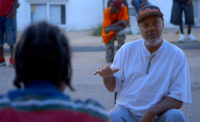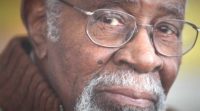Nearly 60 years ago, Italian filmmaker Michelangelo Antonioni found an ideal antagonist in Modernism. The stone-and-mortar permanence of the classical was overtaken and erased by the glass-walled ephemerality of the modern, and characters in films like L’Avventura and La Notte find their post-war spiritual malaise framed and exacerbated by the changing landscape.
Today, Modernism, like so many forms of midcentury expression, is up for reconsideration. And when it comes to its cinematic representation, the mode gets a mediative yet passionate defense in Columbus, the first feature by director and video essayist Kogonada, which opened August 4.
Shot on location in the Modernist mecca of Columbus, Indiana, the film is a familiar kind of coming-of-age story. Casey (Haley Lu Richardson), a young architecture obsessive, puts her aspirations on hold to care for her recovering-addict mother. She meets Jin (John Cho), the son of a prominent Korean architect who fell seriously ill hours before delivering a speech in Columbus. Over the course of their budding relationship, both Casey and Jin challenge each other to make painful decisions that upend their trajectories.
Kogonada, who also wrote and edited Columbus, frames this deceptively-slight narrative around a compelling investigation of place. “For me, Modernism seeks to engage and find meaning in absence,” Kogonada says. “The presence of glass, light, walls, and cantilevered beams reveal absence. So emptiness is literally constructed in meaningful ways. The town of Columbus is surrounded by buildings that are thoughtfully and artistically engaging the modern condition, whether we choose to see it or ignore it.”
The director provokes awareness of the Modernist Columbus by treating it as one of the film’s characters. It’s both protagonist and nemesis for Casey and Jin as they wander the city, explore its architectural bounty (from Eero Saarinen’s Miller House, to Eliel Saarinen’s First Christian Church, to Edward Bassett’s City Hall building), and find it both reflecting inner struggles and inspiring epiphanies.
It’s an arc that follows Kogonada’s experience with the city. The director first encountered Columbus about two and a half years ago. He was taken by “this town haunted by the promise of modernism,” and immediately knew he had to make a film there. “I was working on some story ideas that were going to revolve around children and the burdens they feel with their parents and absence. But it was deeply related to this larger question of how we live in a modern world, and what it means to be modern,” Kogonada says. “So when I visited Columbus, it felt like the embodiment of all the stuff I had been considering.”
Kogonada was born in Seoul and grew up in the Midwest. He always loved architecture, and studied Modernism as a grad student. But as an immigrant he viewed it from a non-Western social context. He drew on these experiences to approach Columbus and its built environment with a kind of distance.
“What’s really fascinating about architecture is that we move through these spaces and they almost become invisible to us because they are part of our daily lives,” Kogonada says. “So the way in which those spaces are inhabited and the way they are felt as a kind of part of daily life was a big part of it for me. We get to really feel architecture, not as pure object but as lived spaces.”
This is felt in Columbus’ uncommon tactility. The film luxuriates on rooms and buildings and creates heightened sensory experiences, especially in the soundscape (both in Kogonada’s sound design and the score by the band Hammock). But Kogonada’s sensibility also infuses Columbus with poignancy and gravity. Casey, like most people who grow up in and become inured to a place, has a complicated relationship with her city. But for her (and Jin), Columbus and its architectural legacy resonate in important and therapeutic ways. In one scene, Casey shares a profound, unexpected connection with Deborah Berke’s First Financial. “Suddenly, the place I lived all my life looked different,” Casey says with wonder and satisfaction.
This is a far cry from Antonioni. The existential tension in his films has been overtaken by the reality of endurance, the sleek lines and curtain walls of Modernism now a permanent, celebrated, and protected fixture of the built environment. The structures in Columbus build off, comment on, and confront that legacy — and so does Kogonada. Columbus might look like a standard indie film with gorgeous shots of photogenic buildings (courtesy of cinematographer Elisha Christian), but at its core is a challenging examination of the way place influences human interaction.
“I think that’s the thing that interests me, the relationship between empty spaces and life itself,” Kogonada says. “Having that much time with this town that is this experiment of the impact of Modernism, I think I walk away with more questions. [Making the film] didn’t resolve anything and there were no final answers, but I feel like there’s so much more for me to understand about it.”
Columbus opened in limited release August 4. The city of Columbus opens its annual three-month celebration of architecture, design, and community, Exhibit Columbus, on August 26.










Post a comment to this article
Report Abusive Comment